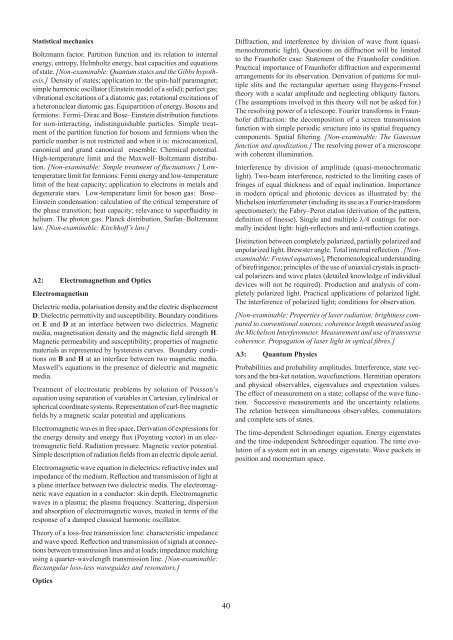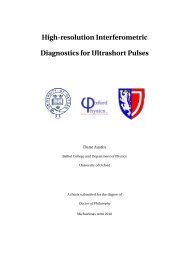Undergraduate Course Handbook - University of Oxford Department ...
Undergraduate Course Handbook - University of Oxford Department ...
Undergraduate Course Handbook - University of Oxford Department ...
You also want an ePaper? Increase the reach of your titles
YUMPU automatically turns print PDFs into web optimized ePapers that Google loves.
Statistical mechanics<br />
Boltzmann factor. Partition function and its relation to internal<br />
energy, entropy, Helmholtz energy, heat capacities and equations<br />
<strong>of</strong> state. [Non-examinable: Quantum states and the Gibbs hypothesis.]<br />
Density <strong>of</strong> states; application to: the spin-half paramagnet;<br />
simple harmonic oscillator (Einstein model <strong>of</strong> a solid); perfect gas;<br />
vibrational excitations <strong>of</strong> a diatomic gas; rotational excitations <strong>of</strong><br />
a heteronuclear diatomic gas. Equipartition <strong>of</strong> energy. Bosons and<br />
fermions: Fermi–Dirac and Bose–Einstein distribution functions<br />
for non-interacting, indistinguishable particles. Simple treatment<br />
<strong>of</strong> the partition function for bosons and fermions when the<br />
particle number is not restricted and when it is: microcanonical,<br />
canonical and grand canonical ensemble. Chemical potential.<br />
High-temperature limit and the Maxwell–Boltzmann distribution.<br />
[Non-examinable: Simple treatment <strong>of</strong> fluctuations.] Lowtemperature<br />
limit for fermions: Fermi energy and low-temperature<br />
limit <strong>of</strong> the heat capacity; application to electrons in metals and<br />
degenerate stars. Low-temperature limit for boson gas: Bose–<br />
Einstein condensation: calculation <strong>of</strong> the critical temperature <strong>of</strong><br />
the phase transition; heat capacity; relevance to superfluidity in<br />
helium. The photon gas: Planck distribution, Stefan–Boltzmann<br />
law. [Non-examinable: Kirchh<strong>of</strong>f’s law.]<br />
A2: Electromagnetism and Optics<br />
Electromagnetism<br />
Dielectric media, polarisation density and the electric displacement<br />
D. Dielectric permittivity and susceptibility. Boundary conditions<br />
on E and D at an interface between two dielectrics. Magnetic<br />
media, magnetisation density and the magnetic field strength H.<br />
Magnetic permeability and susceptibility; properties <strong>of</strong> magnetic<br />
materials as represented by hysteresis curves. Boundary conditions<br />
on B and H at an interface between two magnetic media.<br />
Maxwell’s equations in the presence <strong>of</strong> dielectric and magnetic<br />
media.<br />
Treatment <strong>of</strong> electrostatic problems by solution <strong>of</strong> Poisson’s<br />
equation using separation <strong>of</strong> variables in Cartesian, cylindrical or<br />
spherical coordinate systems. Representation <strong>of</strong> curl-free magnetic<br />
fields by a magnetic scalar potential and applications.<br />
Electromagnetic waves in free space. Derivation <strong>of</strong> expressions for<br />
the energy density and energy flux (Poynting vector) in an electromagnetic<br />
field. Radiation pressure. Magnetic vector potential.<br />
Simple description <strong>of</strong> radiation fields from an electric dipole aerial.<br />
Electromagnetic wave equation in dielectrics: refractive index and<br />
impedance <strong>of</strong> the medium. Reflection and transmission <strong>of</strong> light at<br />
a plane interface between two dielectric media. The electromagnetic<br />
wave equation in a conductor: skin depth. Electromagnetic<br />
waves in a plasma; the plasma frequency. Scattering, dispersion<br />
and absorption <strong>of</strong> electromagnetic waves, treated in terms <strong>of</strong> the<br />
response <strong>of</strong> a damped classical harmonic oscillator.<br />
Theory <strong>of</strong> a loss-free transmission line: characteristic impedance<br />
and wave speed. Reflection and transmission <strong>of</strong> signals at connections<br />
between transmission lines and at loads; impedance matching<br />
using a quarter-wavelength transmission line. [Non-examinable:<br />
Rectangular loss-less waveguides and resonators.]<br />
Optics<br />
Diffraction, and interference by division <strong>of</strong> wave front (quasimonochromatic<br />
light). Questions on diffraction will be limited<br />
to the Fraunh<strong>of</strong>er case. Statement <strong>of</strong> the Fraunh<strong>of</strong>er condition.<br />
Practical importance <strong>of</strong> Fraunh<strong>of</strong>er diffraction and experimental<br />
arrangements for its observation. Derivation <strong>of</strong> patterns for multiple<br />
slits and the rectangular aperture using Huygens-Fresnel<br />
theory with a scalar amplitude and neglecting obliquity factors.<br />
(The assumptions involved in this theory will not be asked for.)<br />
The resolving power <strong>of</strong> a telescope. Fourier transforms in Fraunh<strong>of</strong>er<br />
diffraction: the decomposition <strong>of</strong> a screen transmission<br />
function with simple periodic structure into its spatial frequency<br />
components. Spatial filtering. [Non-examinable: The Gaussian<br />
function and apodization.] The resolving power <strong>of</strong> a microscope<br />
with coherent illumination.<br />
Interference by division <strong>of</strong> amplitude (quasi-monochromatic<br />
light). Two-beam interference, restricted to the limiting cases <strong>of</strong><br />
fringes <strong>of</strong> equal thickness and <strong>of</strong> equal inclination. Importance<br />
in modern optical and photonic devices as illustrated by: the<br />
Michelson interferometer (including its use as a Fourier-transform<br />
spectrometer); the Fabry–Perot etalon (derivation <strong>of</strong> the pattern,<br />
definition <strong>of</strong> finesse). Single and multiple λ/4 coatings for normally<br />
incident light: high-reflectors and anti-reflection coatings.<br />
Distinction between completely polarized, partially polarized and<br />
unpolarized light. Brewster angle. Total internal reflection . [Nonexaminable:<br />
Fresnel equations], Phenomenological understanding<br />
<strong>of</strong> birefringence; principles <strong>of</strong> the use <strong>of</strong> uniaxial crystals in practical<br />
polarizers and wave plates (detailed knowledge <strong>of</strong> individual<br />
devices will not be required). Production and analysis <strong>of</strong> completely<br />
polarized light. Practical applications <strong>of</strong> polarized light.<br />
The interference <strong>of</strong> polarized light; conditions for observation.<br />
[Non-examinable: Properties <strong>of</strong> laser radiation; brightness compared<br />
to conventional sources; coherence length measured using<br />
the Michelson Interferometer. Measurement and use <strong>of</strong> transverse<br />
coherence. Propagation <strong>of</strong> laser light in optical fibres.]<br />
A3: Quantum Physics<br />
Probabilities and probability amplitudes. Interference, state vectors<br />
and the bra-ket notation, wavefunctions. Hermitian operators<br />
and physical observables, eigenvalues and expectation values.<br />
The effect <strong>of</strong> measurement on a state; collapse <strong>of</strong> the wave function.<br />
Successive measurements and the uncertainty relations.<br />
The relation between simultaneous observables, commutators<br />
and complete sets <strong>of</strong> states.<br />
The time-dependent Schroedinger equation. Energy eigenstates<br />
and the time-independent Schroedinger equation. The time evolution<br />
<strong>of</strong> a system not in an energy eigenstate. Wave packets in<br />
position and momentum space.<br />
40










![Extended Notes 8 [pdf]](https://img.yumpu.com/50123548/1/190x245/extended-notes-8-pdf.jpg?quality=85)




![Handout 3 [pdf] - University of Oxford Department of Physics](https://img.yumpu.com/46475432/1/190x245/handout-3-pdf-university-of-oxford-department-of-physics.jpg?quality=85)